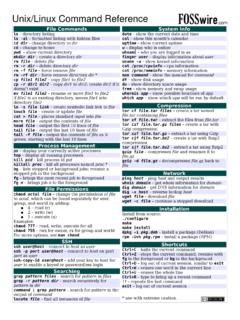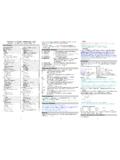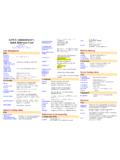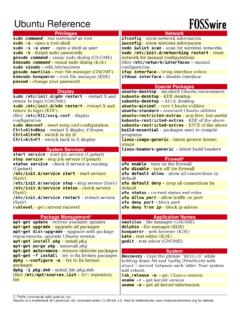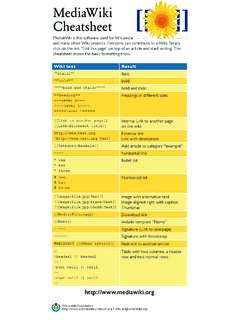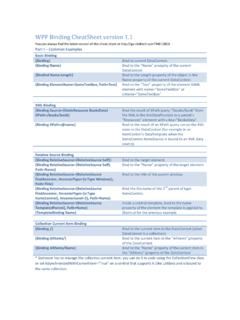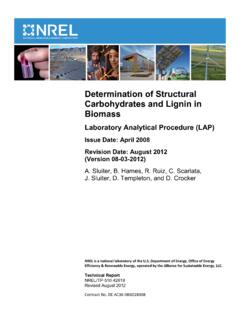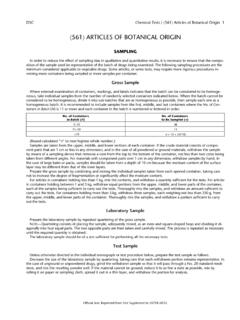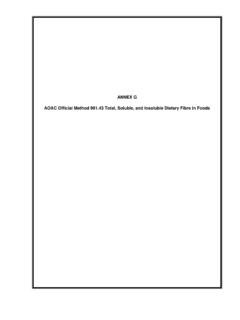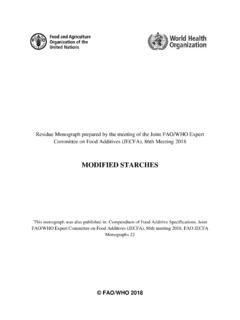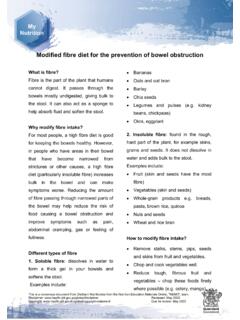Transcription of Chemistry Salt Analysis Cheatsheet 2 4 5
1 Chemistry salt Analysis CheatsheetVersion 2008 Ankur BanerjeeAll Rights important stuff for CBSE Class 12th Chemistry practical syllabus has been included, not mentioned next to group is the preliminary test; the ones mentioned under an anion are confirmatory tests for I (dilute H2SO4 group) CO32- (carbonate), SO32- (sulphite), S2- (sulphide), NO2- (nitrite): salt + dil reaction: Group I anion not present. Continue to group : Colourless and odourless gas (CO2) 1 + MgSO4 = white : Colourless gas with pungent + BaCl2 (aq) = white ppt soluble in dil HCl1 Water extract: Pinch of salt + + acidified K2Cr2O7 2 = sol 3 turns + acidified KMnO4 = pink colour of KMnO4 is : Colourless gas with a smell of rotten eggs (H2S); turns lead acetate paper nitroprusside test: WE + sodium nitroprusside 4 = purple / violet acetate test: WE + lead acetate 5 (aq) = black : Pungent light brown test: WE + dil H2SO4 (or dil acetic acid); boil, then add solid KI + fresh starch sol = deep blue colourationGroup II (conc H2SO4 group) Cl- (chloride), Br- (bromide), I- (iodide), NO3- (nitrate), CH3 COO- (acetate), C2O42- (oxalate): salt + conc reaction: Group II anion not present.
2 Continue to group : Colourless white pungent fumes (HCl); intensify when glass rod dipped in NH4OH is brought near mouth of test nitrate test: WE + AgNO3 = white ppt soluble in chloride test: salt + solid K2Cr2O7 + 2-3 drops conc H2SO4 = orange / red fumes of chromyl chloride + NaOH (aq) = yellow solution + acetic acid + lead acetate sol = yellow ppt2 Potassium dichromate3 Solution4 Na2[Fe(CN)5NO]5 Pb(CH3 COO)26 : Reddish brown nitrate test: WE + AgNO3 (aq) = yellow ppt partially soluble in layer test: WE + CCl4 + 1 drop conc HNO3 = Upper layer aqueous; lower layer organic of orange / brown colour (bromine is soluble in non-polar solvent) : Violet nitrate test: WE + AgNO3 (aq) = yellow ppt insoluble in layer test: WE + CCl4 + 1 drop conc HNO3 = Upper layer aqueous; lower layer organic of violet colour (iodine is soluble in non-polar solvent) : Brown fumes with pungent smell, which intensify on adding paper pellets (may need heating) ring test: WE + freshly prepared FeSO4 sol + 1 drop conc HNO3 added along side of test tube = brown ring formed at junction of sol and : Pungent vapour with vinegar-like test: salt + conc H2SO4 + ethanol = fruity smell of chloride test: WE + FeCl3 (aq) = brick red dil HCl = red colour water and boil = reddish brown : Colourless gas with effervescence (CO + CO2) chloride test: WE + acetic acid + CaCl2 (aq) + boil = white ppt; ppt dissolves when dil HNO3 is added and permanganate test: salt + dil H2SO4 + heat.
3 Then add 2-3 drops KMnO4 sol = pink colour of KMnO4 is dischargedGroup III anions (special group) SO42- (sulphate), PO43- (phosphate): No group chloride test: WE + BaCl2 (aq) = white ppt insoluble in conc acetate test: WE + lead acetate (aq) + acetic acid = white ppt soluble in CH3 COONH (ammonium acetate) molybdate test: WE + dil HNO3 + ammonium molybdate 7 + boil = crystalline canary yellow pptCations Group reagent is mentioned next to group cations. Test mentioned next to cation is the preliminary; ones under it are confirmatory tests for it. When sulphate is detected, Ba2+, Ca2+, Pb2+, and Sr2+ are not present as sulphates of these radicals are insoluble . When phosphate is detected, cations of group III and later are (NH4) 0 NH4+ (ammonium): No group hydroxide test: salt + NaOH = pungent smelling gas; gives white fumes when a glass rod dipped in conc HCl is brought near mouth of test 's reagent 8 test: OS 9 + NaOH + Nessler's reagent = Brown / yellow pptGroup I Pb2+ (lead): OS + dil HCl = white ppt; add water, boil, and divide into three OS undisturbed = white crystals formed on iodide test: OS + KI = yellow chromate test: OS + K2 CrO4 = yellow pptGroup II Cu2+ (copper): OS + dil HCl + H2S = black off extra sol, retain ppt, and dissolve in a few drops of conc HNO3 = bluish green sol, ppt dissolves.
4 Divide into two 1 + excess NH4OH = blue coloured ferrocyanide test: Part 2 + acetic acid + K4[Fe(CN)6] = reddish brown / chocolate coloured ppt (Note this test is difficult to get)Group III Fe2+, Fe3+ (iron), Al3+ (aluminium): OS + solid NH4Cl + excess + / Fe3+: Note ferrous salts are green in colour, ferric salts are brown in K2 HgI49 Original solution: salt + acid + ferrous salt has been given, convert to ferric: OS + conc HNO3 + heat = brown ppt; then do reaction with group ppt + HCl; then divide into two ferrocyanide test: Part 1 + K4[Fe(CN)6] = blue ppt / thiocyanate test: Part 2 + KCNS = blood red +: Gelatinous white lake test: Retain ppt + dil HCl = clear + blue litmus and NH4OH (drop-by-drop) = blue colour layer ('lake') floats over colourless solGroup IV Co2+ (cobalt), Ni2+ (nickel), Mn2+ (manganese), Zn2+ (zinc): OS + solid NH4Cl + excess NH4OH + pass H2S + / Ni2+: Black ppt; dissolve ppt in aqua regia 10 and evaporate sol to dryness to get +: Blue residue; turns pink / purple when dissolved in water; divide into two 1 + dil acetic acid + KNO2 + warm = yellow 2 + ether (1 mL) + solid NH4 CNS 11 = blue colour in +: Yellow residue; turns green when dissolved in water; divide into two parts10 Aqua regia: 3 parts conc HCl + 1 part conc HNO311 Ammonium 12 test: Part 1 + excess NH4OH + DMG = bright red 2 + NaOH + bromine water + boil = black +: Buff / skin colour ppt; divide into two 1 + dil HCl + boil off H2S + NaOH = white ppt; which turns black / brown on adding bromine dioxide test: Part 2 + PbO2 + conc HNO3 + boil = after cooling; pink +: Greyish white ppt; divide into two 1 + excess NaOH = white ppt ferrocyanide test: Part 2 + K4[Fe(CN)6] = white / bluish white pptGroup V Ba2+ (barium), Sr2+ (strontium), Ca2+ (calcium):OS + (NH4)2CO3 + NH4Cl + NH4OH = white ppt.
5 Add dil acetic acid, divide sol into three parts and test for following IN +: Part 1 + excess K2 CrO4 13 (aq) = yellow +: Part 2 + (NH4)2SO4 (aq) = white +: Part 3 + (NH4)2C2O4 14 (aq) + NH4OH (only if nothing appears at first) = white test: Take salt and make a paste by mixing with conc HCl. Take paste on tip of glass rod / platinum wire, and put in Bunsen burner +: Green +: Crimson red +: Brick red flame12 Dimethyl glyoxime reagent13 Potassium chromate14 Ammonium oxalateGroup VI Mg2+ (magnesium): No group reagentOS + NH4Cl + excess NH4OH + ammonium phosphate = white pptColoured saltsColourInferenceBlueCupric saltsGreenHydrated nickel saltsRose redCobalt salts, HgI2 Light greenFerrous saltsYellow / brownFerric saltsGreen / blueHydrated copper saltsDeep blueAnhydrous cobalt saltsPale pinkManganese saltsDark green / purpleChromic saltsMiscellaneous Notes With Br-, most labs only have NH4+. With Ca2+, most labs only have Cl-. Easier way to do flame test: Use test tube holder as tongs, and pick up a sizeable chunk of salt with it.
6 Put one drop of conc HCl, and put in Bunsen burner flame. Do flame test first; if you're lucky you'll get your cation early. Most students spend up a lot of time doing cation
